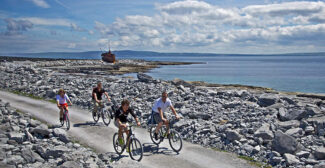Get Off the Grid on the Mountain Loop Highway
Washington’s Mountain Loop Highway into the heart of the Cascades guarantees stunning scenery and tranquil isolation through the Mount Baker-Snoqualmie National Forest and along the Stillaguamish and Sauk river valleys.
Miners struck gold deep in the Cascades in the summer of 1889 and the rush was on. A town sprang up below the mountain mines and a railway soon followed.
The railway opened what is now the Mountain Loop Highway, where you’ll find small towns and rugged surroundings, sweeping Cascade views, sparkling alpine lakes and a gold rush ghost town.
Check with the national forest for road and facility closures before you go, and call or go online to confirm the availability of specific attractions and services such as fuel, lodging, restaurants, seasonal events and gatherings.

When and How to Go
Head to the Mountain Loop Highway in late summer or early fall. You can complete this road trip in a day, or break it up into three or four days to take full advantage of the hiking, rock climbing, whitewater rafting and other outdoor activities.
The official scenic byway starts in Granite Falls and ends in Darrington. To make it a 95-mile loop, start in historic Arlington, follow Jordan Road along the Stillaguamish River to Granite Falls, then take the roundabout to state Route 92 East and turn left onto the Mountain Loop Highway. The drive officially ends in Darrington, but continue to Arlington to complete the loop.
Gas up before you go and take it slow on the 13-mile stretch of single-lane, gravel road on the east side of the loop. If you’re curious about this region’s history, Snohomish County has a Mountain Loop Tour app (for iOS and Android) that provides facts along the way.

Mountain Loop Highway Daytrip
These roadside stops and short walks will allow you to take in this drive’s stunning sights in a single day.
The Granite Falls Fish Ladder was the longest in the world when it was built in the 1950s. Take the 0.7-mile (round-trip) trail to see this 540-foot fishway and its 280-foot tunnel that let salmon and steelhead reach their spawning grounds.
Continuing east on the loop, pulling off at the Big Four Ice Caves Picnic Area for a look at the north face of Big Four Mountain. The snow caves that form in late summer are normally an easy walk from here.
After you round the bend and start heading north, the White Chuck Overlook Picnic Area offers the panoramic mountain sights you came for. White Chuck Mountain meets the sky above the forested valley, and you might spot mountain goats in late summer and early fall.
As you drive out of the mountains, you’ll come to Darrington, where rugged peaks are visible from its cozy downtown. Past Darrington is the site of the 2014 landslide that devastated the small community of Oso, where you can pause at the memorial project to remember those who were lost.

Remote Outdoor Experiences
If you’ve got more than just a day to spend on the Mountain Loop Highway, endless outdoor recreation awaits. Here are the best options to fill out a multi-day trip if you’ve got an appetite for adventure, but trail difficulty and road conditions vary.
Heather Lake is a steep 4.6-mile round-trip hike ending at a crystal-clear alpine lake on the northeastern slope of Mount Pilchuck. If you’re looking for something a little more challenging (but with an easily accessible trailhead), the Lake 22 trail climbs through old-growth mountain rainforest to a lake and wetlands on Mount Pilchuck.
On the eastern edge of the loop, Barlow Pass offers two great options, each with looming mountain peaks, an abundance of late-July wildflowers and serious elevation gain. The first is an 8-mile (round-trip) hike to the ghost town of Monte Cristo, a once bustling mining establishment that is now equally spooky and beautiful. The second option is the longer, steeper Gothic Basin out-and-back, a strenuous climb that some make into a backpacking trip.
The 10.4-mile round-trip Goat Lake Trail offers a bit of everything with lush forest, waterfalls and a striking blue-green alpine lake reflecting snowy peaks.
One of the most difficult treks is Mount Pugh Trail, but the reward is a breathtaking 360-degree view of Glacier Peak, Mount Baker, Three Fingers, Mount Rainier and the Olympics.
Go vertical with rock climbing at Vesper Peak, Mount Pilchuck and the Granite Falls Fish Ladder.
For something a bit flatter, the 6-mile round-trip Old Sauk River Trail follows the river through mossy forest. Or experience the river a wetter way with whitewater rafting from late May through early August.

Making it a Trip: Where to Stay
Camping, glamping and lodging is all available along the Mountain Loop Highway, but make sure to check online or call before you go.
Camp in the Mount Baker-Snoqualmie National Forest along the Stillaguamish River at the Verlot campground or along the Sauk River at Bedal Campground, which is about halfway around the loop.
Snohomish County’s Squire Creek Park and Campground has RV and tent camping among the beautiful moss-laden trees of an old-growth forest.
–Written by Julia-Grace Sanders and last updated in September 2022.









